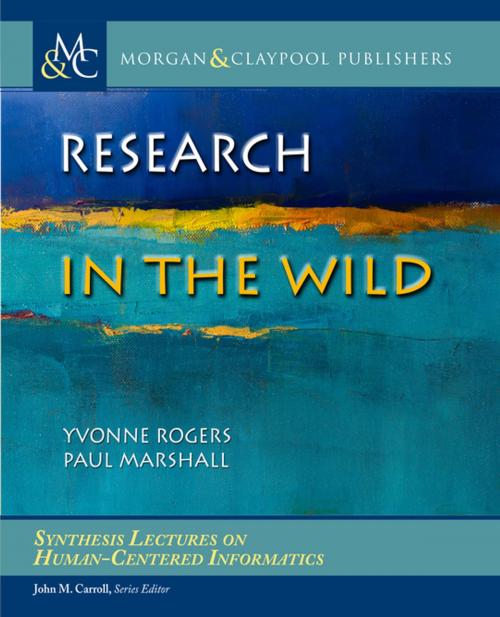Research in the Wild
Nonfiction, Computers, Advanced Computing, Computer Science, Information Technology| Author: | Yvonne Rogers, Paul Marshall, John M. Carroll | ISBN: | 9781681731971 |
| Publisher: | Morgan & Claypool Publishers | Publication: | April 4, 2017 |
| Imprint: | Morgan & Claypool Publishers | Language: | English |
| Author: | Yvonne Rogers, Paul Marshall, John M. Carroll |
| ISBN: | 9781681731971 |
| Publisher: | Morgan & Claypool Publishers |
| Publication: | April 4, 2017 |
| Imprint: | Morgan & Claypool Publishers |
| Language: | English |
The phrase "in-the-wild" is becoming popular again in the field of human-computer interaction (HCI), describing approaches to HCI research and accounts of user experience phenomena that differ from those derived from other lab-based methods. The phrase first came to the forefront 20-25 years ago when anthropologists Jean Lave (1988), Lucy Suchman (1987), and Ed Hutchins (1995) began writing about cognition being in-the-wild. Today, it is used more broadly to refer to research that seeks to understand new technology interventions in everyday living.
A reason for its resurgence in contemporary HCI is an acknowledgment that so much technology is now embedded and used in our everyday lives. Researchers have begun following suit—decamping from their usability and living labs and moving into the wild; carrying out in-situ development and engagement, sampling experiences, and probing people in their homes and on the streets.
The aim of this book is to examine what this new direction entails and what it means for HCI theory, practice, and design. The focus is on the insights, demands and concerns. But how does research in the wild differ from the other applied approaches in interaction design, such as contextual design, action research, or ethnography? What is added by labeling user research as being in-the-wild? One main difference is where the research starts and ends: unlike user-centered, and more specifically, ethnographic approaches which typically begin by observing existing practices and then suggesting general design implications or system requirements, in-the-wild approaches create and evaluate new technologies and experiences in situ(Rogers, 2012). Moreover, novel technologies are often developed to augment people, places, and settings, without necessarily designing them for specific user needs. There has also been a shift in design thinking. Instead of developing solutions that fit in with existing practices, researchers are experimenting with new technological possibilities that can change and even disrupt behavior. Opportunities are created, interventions installed, and different ways of behaving are encouraged. A key concern is how people react, change and integrate these in their everyday lives. This book outlines the emergence and development of research in the wild. It is structured around a framework for conceptualizing and bringing together the different strands. It covers approaches, methods, case studies, and outcomes. Finally, it notes that there is more in the wild research in HCI than usability and other kinds of user studies in HCI and what the implications of this are for the field.
The phrase "in-the-wild" is becoming popular again in the field of human-computer interaction (HCI), describing approaches to HCI research and accounts of user experience phenomena that differ from those derived from other lab-based methods. The phrase first came to the forefront 20-25 years ago when anthropologists Jean Lave (1988), Lucy Suchman (1987), and Ed Hutchins (1995) began writing about cognition being in-the-wild. Today, it is used more broadly to refer to research that seeks to understand new technology interventions in everyday living.
A reason for its resurgence in contemporary HCI is an acknowledgment that so much technology is now embedded and used in our everyday lives. Researchers have begun following suit—decamping from their usability and living labs and moving into the wild; carrying out in-situ development and engagement, sampling experiences, and probing people in their homes and on the streets.
The aim of this book is to examine what this new direction entails and what it means for HCI theory, practice, and design. The focus is on the insights, demands and concerns. But how does research in the wild differ from the other applied approaches in interaction design, such as contextual design, action research, or ethnography? What is added by labeling user research as being in-the-wild? One main difference is where the research starts and ends: unlike user-centered, and more specifically, ethnographic approaches which typically begin by observing existing practices and then suggesting general design implications or system requirements, in-the-wild approaches create and evaluate new technologies and experiences in situ(Rogers, 2012). Moreover, novel technologies are often developed to augment people, places, and settings, without necessarily designing them for specific user needs. There has also been a shift in design thinking. Instead of developing solutions that fit in with existing practices, researchers are experimenting with new technological possibilities that can change and even disrupt behavior. Opportunities are created, interventions installed, and different ways of behaving are encouraged. A key concern is how people react, change and integrate these in their everyday lives. This book outlines the emergence and development of research in the wild. It is structured around a framework for conceptualizing and bringing together the different strands. It covers approaches, methods, case studies, and outcomes. Finally, it notes that there is more in the wild research in HCI than usability and other kinds of user studies in HCI and what the implications of this are for the field.















